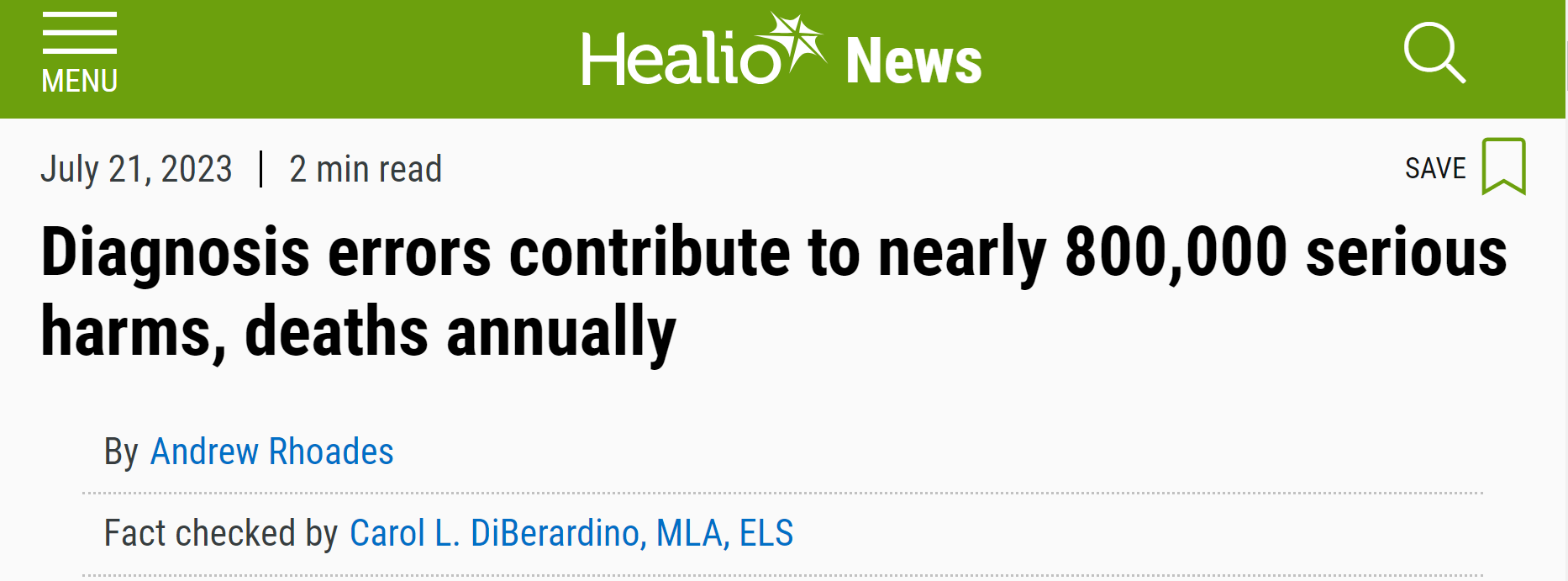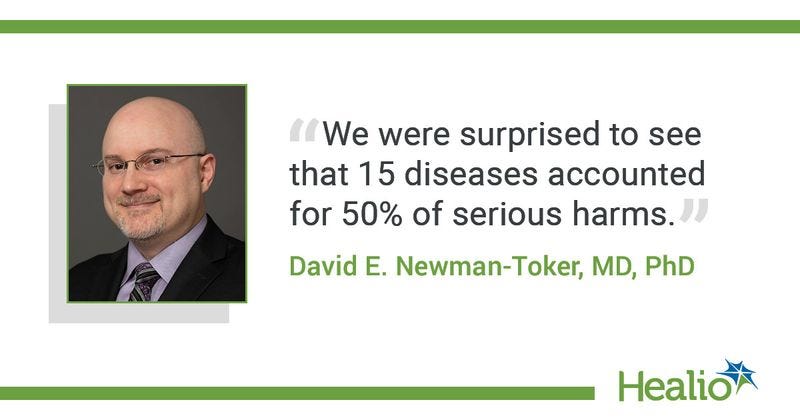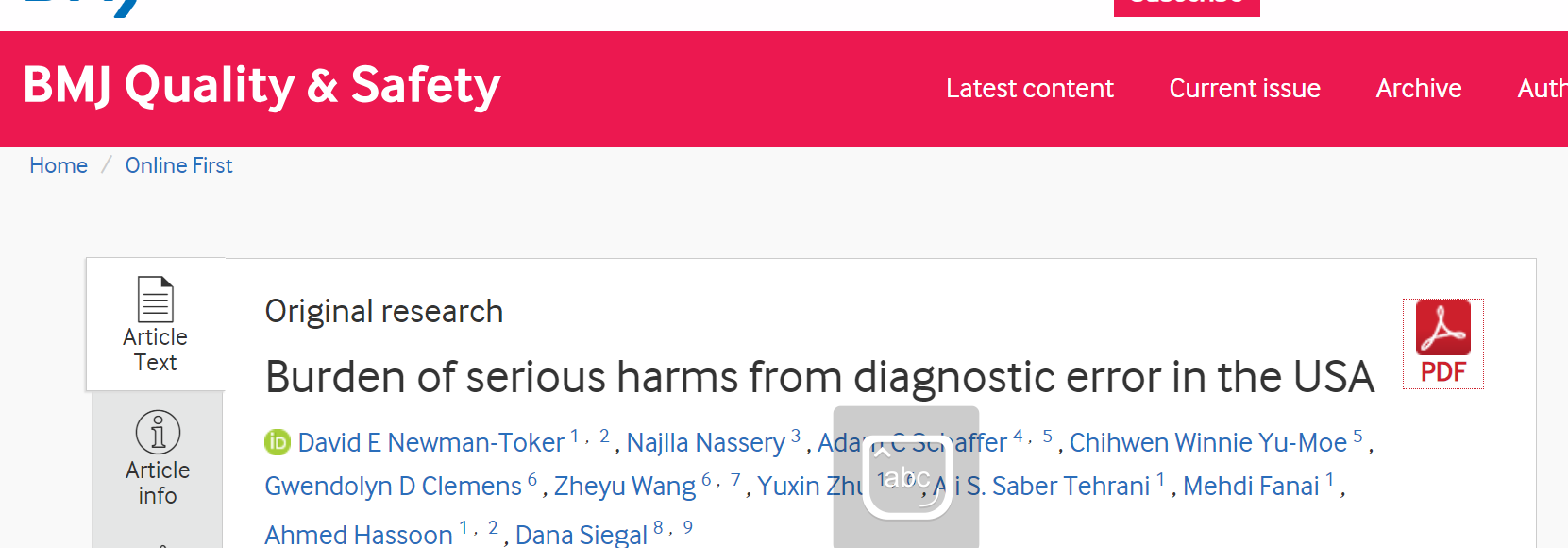health strategy review
management, engineering and
technology review
Joaquim Cardoso MSc.
Senior Research and Strategy Officer (CRSO),
Chief Editor and Senior Advisor
January 22, 2023
Key takeaways:
- An estimated 795 000 Americans become permanently disabled or die annually across care settings because dangerous diseases are misdiagnosed.
- Just 15 diseases account for about half of all serious harms, so the problem may be more tractable than previously imagined.
- The 15 dangerous diseases accounted for 50.7% of total serious harms …
- and the top 5 (stroke, sepsis, pneumonia, venous thromboembolism and lung cancer) accounted for 38.7%.
- “Research needs to develop similar, multifaceted solutions for other diseases, such as stroke — we need a mix of teamwork, training, technology, and tuning (feedback) to create multiple safety nets, then studies to demonstrate their impact in real-world practice.
- The large burden of diagnostic errors warrants additional efforts to improve diagnoses.
DEEP DIVE

Diagnosis errors contribute to nearly 800,000 serious harms, deaths annually
Healio
Andrew Rhoades
Fact checked by Carol L. DiBerardino, MLA, ELS
July, 2023
An estimated 795,000 people are permanently disabled or die from misdiagnoses each year in the United States, according to a study recently published in BMJ Quality and Safety.
“In 2015, the National Academy of Medicine stated in their report ‘Improving Diagnosis in Healthcare’ that improving diagnosis was a ‘moral, professional, and public health imperative’ yet also noted that ‘the available research [is] not adequate to extrapolate a specific estimate or range of the incidence of diagnostic errors in clinical practice today,’”
David E. Newman-Toker, MD, PhD, a professor of neurology at John Hopkins Medicine, told Healio. “We sought a scientifically robust answer to the question of how many patients in the U.S. suffer serious harms as a result of medical misdiagnosis.”

Newman-Toker and colleagues performed a cross-sectional analysis using 2012 to 2014 hospital discharge data to examine annual vascular and infection incidents and 2014 U.S. registry data to examine annual new cancers. They then multiplied national estimates for diseases in each of the “big three” categories by the proportion of patients with that disease who experienced a misdiagnosis or serious harm.
The researchers found that annually, there were 6 million vascular incidents, 6.2 million infections and 1.5 million cancers in the U.S. The weighted mean diagnostic error and serious harm rates were 11.1% and 4.4%, respectively, per disease case.
The estimated annual number of serious harms was 795,000, but in a sensitivity analysis, this was reduced to 549,000.
The top 15 diseases in each disease category accounted for 50.7% of all serious harms, while the top five diseases — sepsis, venomous thrombosis, stroke, lung cancer and pneumonia — accounted for 38.7%.
Although the researchers expected the annual number of serious harms to be high and were not surprised of the diseases that were often culprits, “we were surprised to see that 15 diseases accounted for 50% of serious harms and the five most frequently harmful accounted for nearly 40% of serious harms,” Newman-Toker said.
Newman-Toker and colleagues suggested that because of the lower number of diseases that heavily contribute to misdiagnoses and serious harms, “meaningful progress” could be made by addressing “just a few dangerous diseases that are relatively common.”
Newman-Toker added that malpractice claims in primary care are often missed cancer diagnoses; however, “it is likely that missed vascular events and infections more often result in serious harms to patients.”
“This is because of the much higher frequency of vascular events (~6 million U.S. cases per year) and infections (~6.2 million U.S. cases per year) relative to cancers (~1.5 million U.S. cases per year), with comparable diagnostic error rates,” he said.
“The cancers are likely overrepresented in malpractice claims because there are more opportunities over time to miss a diagnosis and there is often a ‘paper trail’ (eg, a missed lung nodule on a chest x-ray).”
Future research, Newman-Toker said, should look to heart attack diagnoses in patients with chest pain as a “‘shining star’ example of what can be accomplished when we devote significant resources to addressing the problem of diagnostic error.”
Future research, Newman-Toker said, should look to heart attack diagnoses in patients with chest pain as a “‘shining star’ example of what can be accomplished when we devote significant resources to addressing the problem of diagnostic error.”
“We found serious harm rates below 1% of heart attack cases,” he said.
“Research needs to develop similar, multifaceted solutions for other diseases, such as stroke — we need a mix of teamwork, training, technology, and tuning (feedback) to create multiple safety nets, then studies to demonstrate their impact in real-world practice.
“Research needs to develop similar, multifaceted solutions for other diseases, such as stroke — we need a mix of teamwork, training, technology, and tuning (feedback) to create multiple safety nets, then studies to demonstrate their impact in real-world practice.
We need policy action to increase research funding; new quality metrics and regulatory accountability for good diagnostic outcomes; and new payment models to incentivize accurate, timely, and effectively communicated diagnoses.”
ORIGINAL PUBLICATION

Burden of serious harms from diagnostic error in the USA
http://orcid.org/0000-0003-2789-4115
David E Newman-Toker1,2, Najlla Nassery3, Adam C Schaffer4,5, Chihwen Winnie Yu-Moe5, Gwendolyn D Clemens6, Zheyu Wang6,7, Yuxin Zhu1,6, Ali S. Saber Tehrani1, Mehdi Fanai1, Ahmed Hassoon1,2, Dana Siegal8,9
ABSTRACT
Background
- Diagnostic errors cause substantial preventable harms worldwide, but rigorous estimates for total burden are lacking.
- We previously estimated diagnostic error and serious harm rates for key dangerous diseases in major disease categories and validated plausible ranges using clinical experts.
Objective
- We sought to estimate the annual US burden of serious misdiagnosis-related harms (permanent morbidity, mortality) by combining prior results with rigorous estimates of disease incidence.
Methods
- Cross-sectional analysis of US-based nationally representative observational data.
- We estimated annual incident vascular events and infections from 21.5 million (M) sampled US hospital discharges (2012–2014). Annual new cancers were taken from US-based registries (2014).
- Years were selected for coding consistency with prior literature.
- Disease-specific incidences for 15 major vascular events, infections and cancers (‘Big Three’ categories) were multiplied by literature-based rates to derive diagnostic errors and serious harms.
- We calculated uncertainty estimates using Monte Carlo simulations.
- Validity checks included sensitivity analyses and comparison with prior published estimates.
Results
- Annual US incidence was 6.0 M vascular events, 6.2 M infections and 1.5 M cancers.
- Per ‘Big Three’ dangerous disease case, weighted mean error and serious harm rates were 11.1% and 4.4%, respectively.
- Extrapolating to all diseases (including non-‘Big Three’ dangerous disease categories), we estimated total serious harms annually in the USA to be 795 000 (plausible range 598 000–1 023 000).
- Sensitivity analyses using more conservative assumptions estimated 549 000 serious harms.
- Results were compatible with setting-specific serious harm estimates from inpatient, emergency department and ambulatory care.
- The 15 dangerous diseases accounted for 50.7% of total serious harms and the top 5 (stroke, sepsis, pneumonia, venous thromboembolism and lung cancer) accounted for 38.7%.
Conclusion
- An estimated 795 000 Americans become permanently disabled or die annually across care settings because dangerous diseases are misdiagnosed.
- Just 15 diseases account for about half of all serious harms, so the problem may be more tractable than previously imagined.
Originally published
Names mentioned
David E. Newman-Toker, MD, PhD, a professor of neurology at John Hopkins Medicine












